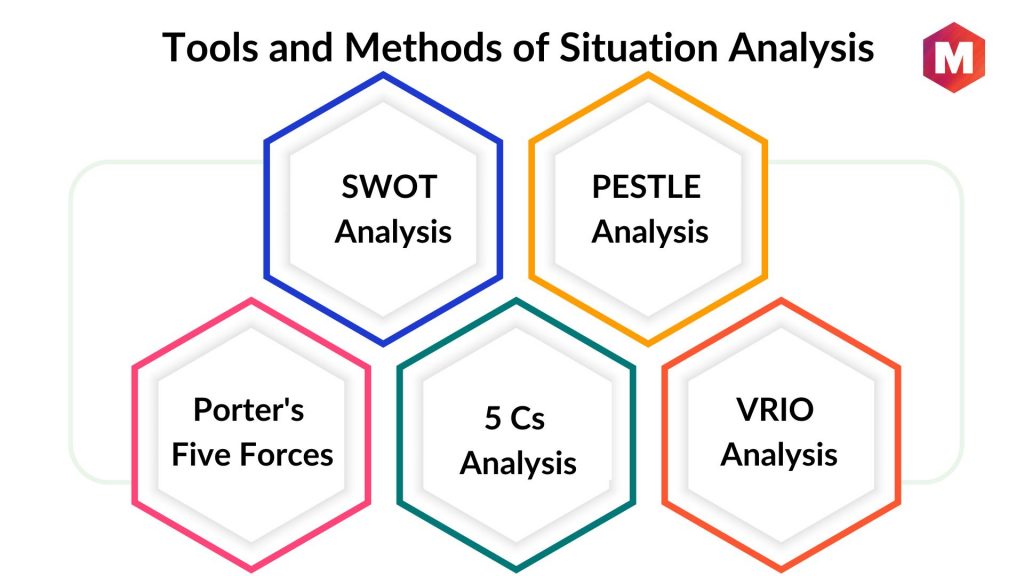At the heart of any successful marketing campaign lies a thorough understanding of the current situation. A situation analysis follows a systematic process to collect and analyze information about the external environment that affects an organization, as well as internal factors such as organizational capabilities and limitations.
Strategic planning begins with a comprehensive situational analysis, so it’s vital to consider both the internal and external conditions affecting an organization. This will allow you to create successful strategies that are tailored to your business’s specific needs and goals. When assessing the internal environment of an organization, one must consider its long-term objectives and strategies, as well as its values.
Table of Contents
What is Situation Analysis?
Situation analysis is a strategic means of collecting and analyzing existing data to create an efficient roadmap for the future. This method helps organizations gain valuable insight into their internal and external environments to make informed decisions.
An example of situation analysis might be to analyze the market trends for a particular product. This could include analyzing customer preferences, competitor products, and pricing strategies, or making predictions about the future of the industry.
Conducting a Situational Analysis is the most integral component of any marketing process. It is vital for organizations to regularly assess their external environment and make necessary changes to remain competitive within the marketplace. A thorough analysis will keep businesses informed of all significant developments, allowing them to be proactive rather than reactive in developing successful strategies.
Importance of Situation Analysis
It is the procedure of collecting and assessing data regarding internal and external factors that can have an effect on your business. This tool allows you to gain a better understanding of how certain changes in market trends or customer preferences may affect your operations, allowing you to adjust accordingly for long-term success.
Successful businesses do useful situational analysis that revolves around different elements like market environment, market research, competitor analysis, internal environmental factors, competitive advantages, marketing strategies, as well as current and potential customers.
It helps businesses by providing an understanding of:
- The business’s current situation
- External and internal factors like economic factors, business partners, environmental regulations, political factors, legal factors, market trends, economic trends, etc may impact the business
- The opportunities and threats that the business face
This understanding helps businesses make informed decisions about where to focus their resources. Additionally, it can help businesses identify new opportunities and develop strategies to mitigate threats.
Finally, it can help businesses track their progress over time and make necessary changes to their plans.
Components You Should Consider During Situation Analysis
1. Product Situation: This involves analyzing the current state of your product including its sales trend, profitability, and customer feedback. It is important to understand how your product is performing in the market, and how it is perceived by the consumers.
2. Competitive Situation: This includes an assessment of your main competitors. Understand their products, marketing strategies, market share, strengths, and weaknesses. This analysis will help you to identify potential threats and opportunities in the market.
3. Distribution Situation: This entails an evaluation of your distribution channels. Assessing the effectiveness of your current distribution strategy and identifying potential improvements can help optimize your product availability and boost sales.
4. Environmental Factors: These are external elements like market conditions, customer behavior, technological changes, legal regulations, and social-cultural factors that can impact your business. Understanding these factors helps you to anticipate changes and adapt your strategy accordingly.
5. Opportunity and Issue Analysis: This involves identifying potential opportunities for growth and issues that might hinder your business’s performance. This could include new market trends, changes in consumer behavior, or challenges with your supply chain.
6. Supply Chain: Assess your business’s supply chain, from sourcing raw materials to the delivery of the final product to the consumer. This analysis can help in identifying any inefficiencies or vulnerabilities in your supply chain that need to be addressed.
Tools and Methods of Situation Analysis
It is a crucial step in understanding the business and developing strategies for growth. By using a variety of data sources and tools, businesses can overcome the challenges associated with Situation Analysis and gain valuable insights into the business.
1. SWOT analysis
A SWOT analysis is a tool that businesses use to assess the strengths, weaknesses, opportunities, and threats facing a company.
2. PESTLE analysis
A PESTLE analysis is a tool that businesses use to assess the political, economic, social, technological, legal, and environmental factors that may impact their business.
3. Porter’s five forces
Porter’s five forces is a tool that businesses use to assess the competitive landscape. The five forces included in this are- Threat of substitutes, the Threat of new competitors, the Threat of established competitors, the Bargaining power of suppliers, and the Bargaining power of customers.
4. 5 Cs Analysis
The 5 C’s of Marketing Analysis is a tool that businesses use to assess the company, customers, collaborators, context, and competitors.
5. VRIO analysis
The VRIO Analysis is a tool that businesses use to assess the company’s internal capabilities. The four components of this are- Value, Rarity, Inimitability, and Organization.
Here is a video by Marketing91 on Situation Analysis.
How to run a Situation Analysis?
1. Analyzing your customers
The first step is to assess your customers. This includes understanding their needs and wants, as well as their buying habits. Additionally, it is important to understand your customer base in order to develop strategies for growth.
2. Analyzing your products and services
The second step is to assess your products and services. It analyzes features and benefits, as well as their strengths and weaknesses. Additionally, it is crucial to know your products and services to make result-driven strategies.
3. Sussing out the competition
The third step is to assess the competition which comprises an understanding of their products and services, alongside their strengths and weaknesses. It further helps in understanding the competitive landscape to develop strategies for growth.
4. Analyzing the environment
The fourth step is to assess the environment. It incorporates an analysis of the political, economic, social, and technological factors that may impact your business. It is critical to understand the environment to make growth-driven strategies.
5. Assessing your resources
The fifth and final step is to assess your resources. It tells about your financial, human, and physical resources. It is significant in gauging your resources to make productive strategies.
Benefits of a Situation Analysis
There are many benefits of conducting a Situation Analysis, including
1. Gain insights into the business: Situation Analysis can provide valuable insights into the business, including the customers, products and services, competition, and environment.
2. Develop strategies for growth: Situation Analysis can help businesses develop strategies for growth by understanding the opportunities and threats facing the business.
3. Identify areas of improvement: Situation Analysis can help businesses identify areas of improvement in order to make the necessary changes.
4. Make informed decisions: Situation company analysis can help businesses make informed decisions by understanding the business and its surroundings.
5. Build a foundation for success: Situation Analysis can help businesses build a solid foundation for success by understanding all aspects of the business that offers a competitive advantage.
Limitations of Situation Analysis
- Time-consuming: Conducting a thorough situation analysis can prove to be an arduous task, with hours of research and data evaluation needed.
- Subjective: The outcomes of a situation analysis are subjective and contingent upon the precision of the data used.
- Limited scope: Situation Analysis is only a partial snapshot of the business and its environment, preventing it from providing an all-encompassing image.
Purpose of a Situation Analysis
By performing analysis, you can gain invaluable insight into your business’s current position in the market, find out what is delivering results and where there are areas for improvement, as well as spot opportunities to capitalize on and expand.
Utilizing a situation analysis produces an effective plan to identify market openings that your business can exploit, develop new technology and respond quickly to shifts in the competition. Adapting this report will give you greater information on where your company is now — and which path it should take for success.
Situation Analysis Example
An e-commerce business may need to conduct a situation analysis to evaluate the impact of digital trends on its customer base. Let’s do 5 C analysis for this example.
- Company: A complete evaluation of the company would include financial analysis, customer engagement metrics, market positioning and performance indicators.
- Customers: Who are the customers? What do they value? What factors influence their buying behavior?
- Competitors: Who is the competition? How do they advertise and promote their products? What strategies do they use to reach their customers?
- Collaborators: Who are the potential partners and suppliers that could give you an edge in the market?
- Context: How is the macro environment impacting your company’s performance? Are there any geopolitical forces, industry regulations or technological advances changing customer dynamics?
How to Tell If a Situational Analysis is Useful for Your Business or Not?
To gain valuable insights for strategic decision-making, it is essential to construct a comprehensive Situational Analysis which should:
- Speak plainly to ensure comprehension by those unfamiliar with the company.
- Identify and prioritize the central elements, both within your business and outside of it, that influence its performance.
- Establish clear and attainable objectives for the coming years to foster business growth.
- Uncover deeper insights
Conclusion!
Situation Analysis is a useful marketing tool that lets businesses gain insights into their current situation, including their strengths and weaknesses, and develop a plan to improve their situation.
What are your thoughts about Situation Analysis? Do you find it a valuable marketing tool? Share your opinion with us in the comment section below.
Want to see how effective situation analysis can drive business success?
A notable example is how Netflix utilized situation analysis in 2020 to respond to the global pandemic. By assessing the surge in home entertainment demand, Netflix expanded its content library and optimized streaming services, leading to a record 36.6 million new subscribers that year (Source: Netflix Annual Report 2020). This strategic move significantly boosted their market position during a challenging time for many industries.
Similarly, Coca-Cola conducted a situation analysis in 2019 to address shifting consumer preferences towards healthier options. By introducing new products like Coca-Cola Energy and expanding their portfolio of low-sugar beverages, they achieved a 6% increase in organic revenues (Source: Coca-Cola 2019 Annual Review). This demonstrates how understanding market trends can lead to successful adaptation and growth.
Liked this post? Check out the complete series on Marketing

